The article I wrote, “Using Math Menus,” appeared in the October 2016 issue of Educational Leadership. I began the article with three questions I’ve been asked by teachers so many times over the years that I’ve named them The Big Three.
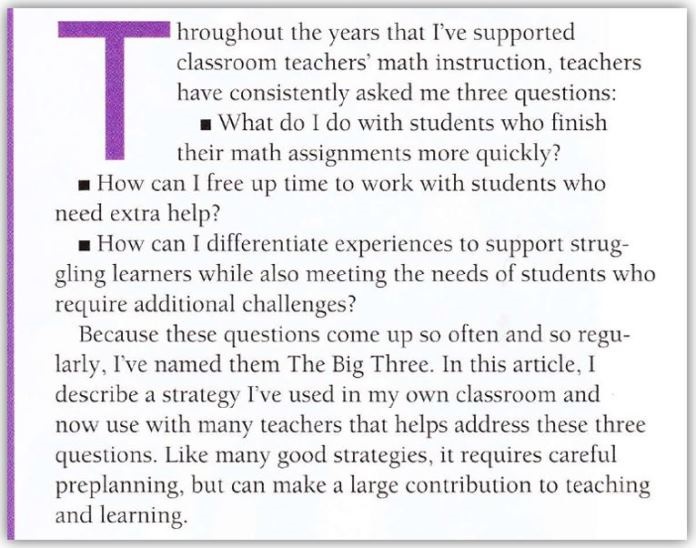
The article explains why I think that using math menus is an effective way to respond to The Big Three. I included a link to the article in a recent blog post I wrote describing a division lesson based on the children’s book 17 Kings and 42 Elephants. I explained how the lesson led to an activity that was perfect for our math menu. Jill Downing, a Title 1 Educator with the Helena Public Schools in Montana, tried the lesson, read my article about math menus, and sent me an email. Here’s an excerpt from that message.
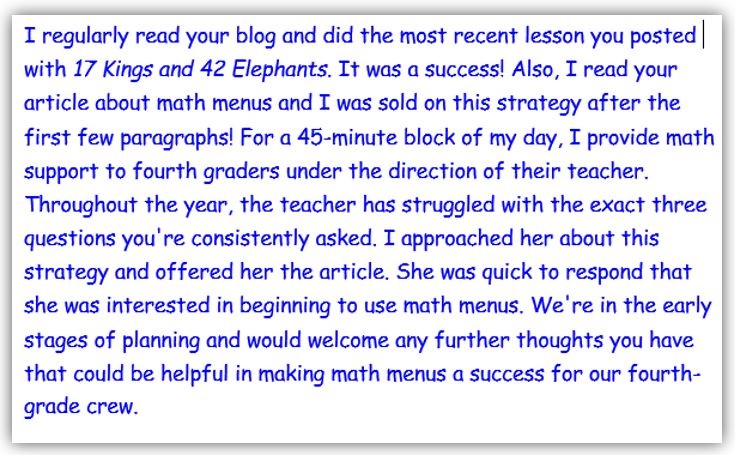
Jill also included in her email three specific queries that relate to nuts and bolts about using math menus.
My Reply to Jill
Before I responded to her specific queries, I gave Jill an update about my current work, explaining in my response that the fourth graders I wrote about in the article are now fifth graders. Sara Liebert is teaching math to the same class for a second year. Most recently the class has been working on whole number division, and here’s their current menu.
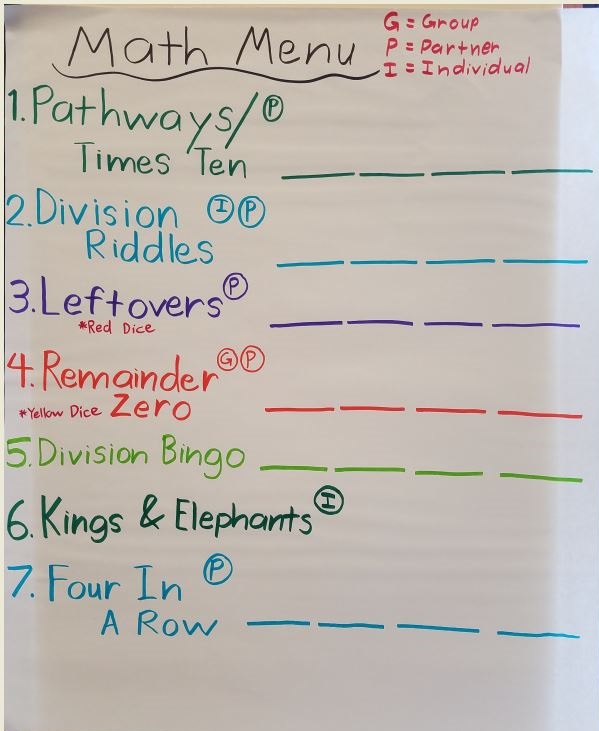
This menu focuses primarily on division, but also supports ongoing work with multiplication and with practicing plotting points on a coordinate plane.
About the menu items, Pathways is a multiplication game that Sara included on the menu because multiplication is so important to division. The game helps students continue practice multiplying as they focus on division. (For more information, read a previous blog post, The Game of Pathways.) The last menu item, Four in a Row, is a coordinate graphing game like Tic-Tac-Toe that involves strategy while giving the students practice plotting points on a coordinate grid. This isn’t related to their current work on division but introduces something the students will be learning a bit later in the year.
Now to the specifics of Jill’s queries.
Jill’s First Query: What methods have you used to track children’s performance on math menu activities?
About your first question, tracking student performance. I think of that in two ways―one is keeping track of what they’ve done and haven’t done, and the other is seeking information about what they’re learning. For tracking what students have and haven’t done, I have several tips.
Tip #1: My favorite method is for each student to make a Math Menu folder. I give them each two sheets of 12-by-18-inch construction paper that they fold―one hamburger style and the other hot dog style―and put together with a few staples or masking tape.
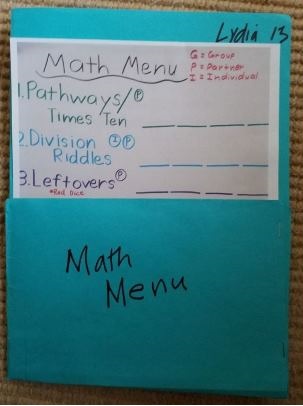
The menu list goes in the front outside pocket and students write new options as they are added to the menu.

Inside students put finished work in the right pocket and unfinished work in the left pocket.
Tip #2: On this menu, all of the choices but one (Kings & Elephants) are partner activities. The four lines after each partner activity is a place for students to write the name of the other student who was their partner, and students have to play with four different partners for each activity. This encourages students to interact with all of their classmates, not just their friends.
Tip #3: Notice the number in the upper right corner of the front of the menu folder. This is an idea I learned from a teacher friend years ago. At the beginning of the year, she assigns each student a number, typically in alphabetical order by their first names―Ana #1, Burt #2, etc. The folders are much easier to file that way, especially when students are organizing them. New students just get the next number in order.
Tip #4: I can easily see what a student has done by looking at the list in the front. It’s easy to look at their lists and record on a class list which menu items I particularly want individuals to try. And I can check any of their work inside.
For the second part of tracking: knowing what students are learning. That depends on the task. There are several division games on the menu, and our goal is for games to provide students practice in different ways that helps them further their skills and cement their understanding. So whatever benchmark or other evaluation we give will help reveal their progress.
Jill’s Second Query: How have you typically set up math materials?
We have math materials organized on shelves and available for students to get as needed and return when they’re through. Some teachers use centers and set out the materials needed for a particular activity.
Jill’s Third Query: How do you structure the reflection time? Do you have children record their reflections in a math journal?
Sara has students write a reflection at the end of every math period. It’s a quiet five minutes. Sara prepares booklets for them which are half sheets of lined newsprint stapled with a construction paper cover. Here are some recent pages from students’ reflection journals.
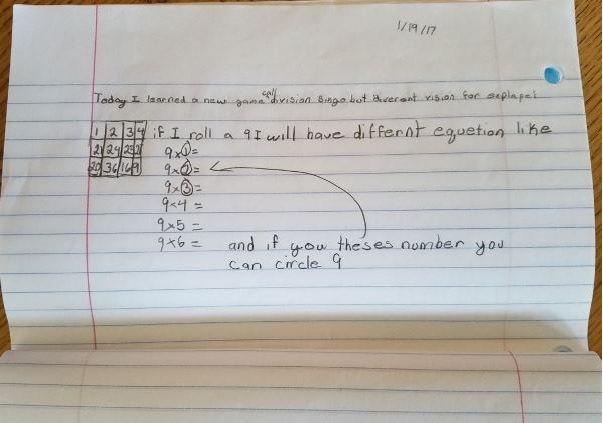
This student wrote about learning to play Division Bingo.

I love this student’s conjecture that division problems with an even divisor and dividend will not have a remainder. We need to talk about problems like 6 ÷ 4!
Sara posted a list of suggestions for students’ reflections that she based on Mark Chubb’s blog Exit Cards―What do yours look like? (Thanks, Mark.)
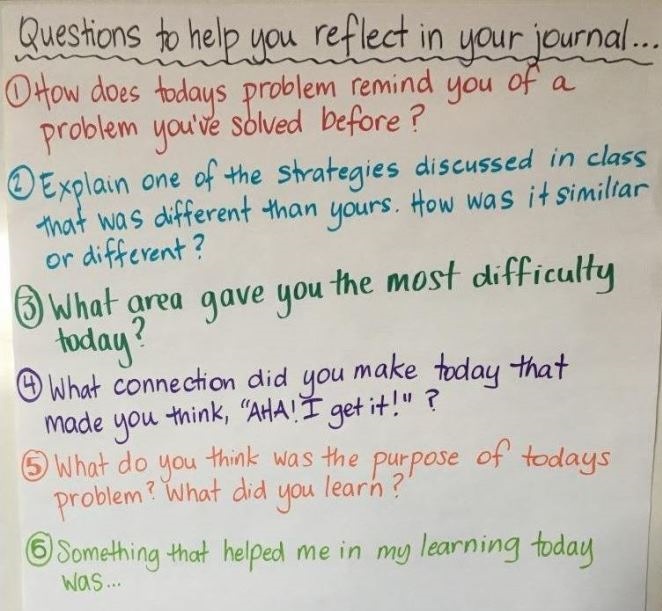
Sometimes Sara points students to a particular suggestion that seems appropriate; other times she asks students to review the list and choose.
Students’ Thoughts about Menus
I shared Jill’s interest with the students and asked them to write her a letter describing their thoughts about the Math Menu―what they like about it, how they feel it helps them learn math, what they would change―whatever they’d like. Jill wrote them a lovely thank-you note for sharing their thoughts.
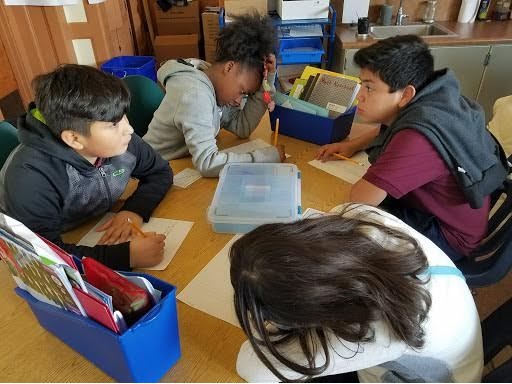
The students were pleased that someone was interested in their ideas and worked hard on their letters.
Here are a few of their letters:
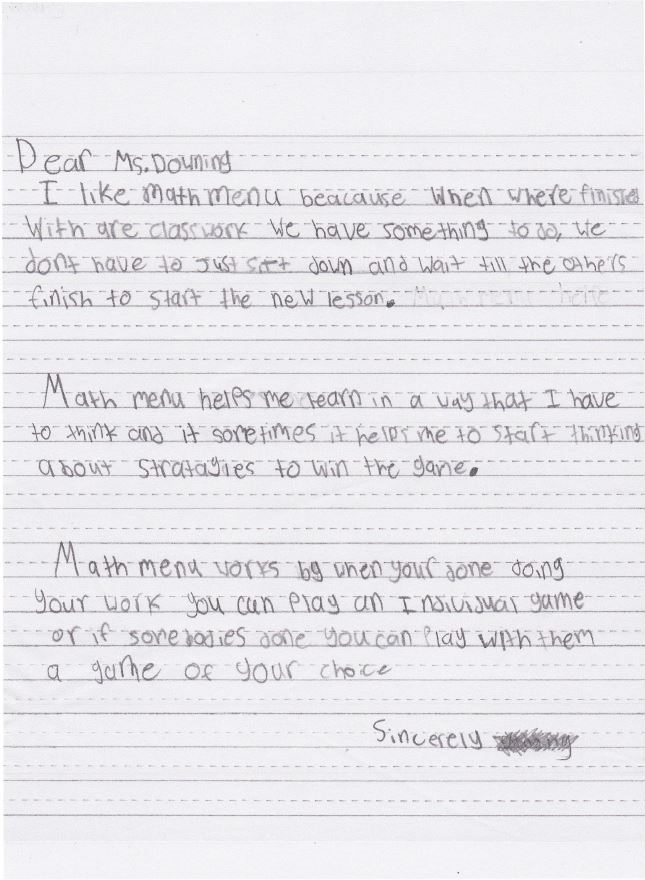
The first sentence in this student’s letter responds directly to the first question in The Big Three.
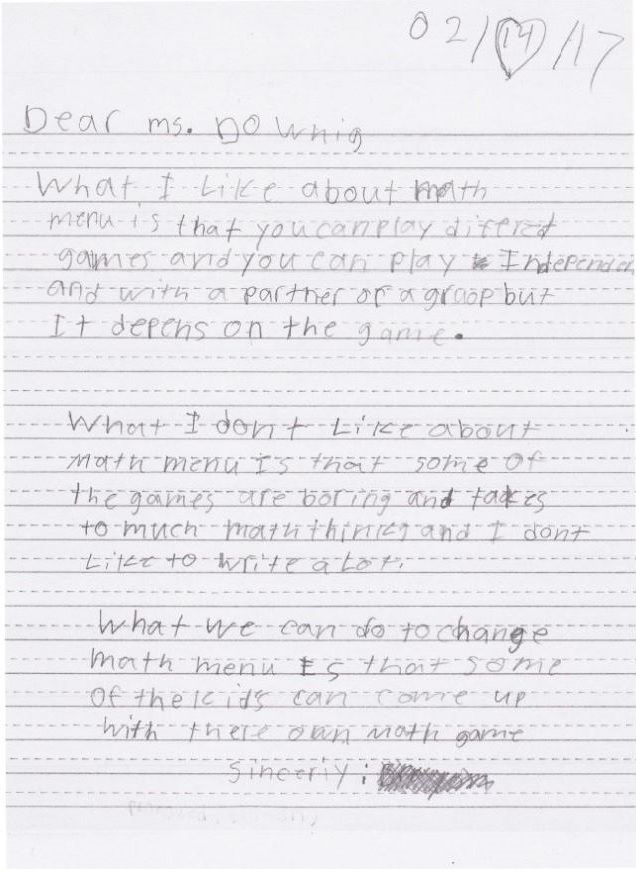
This student wrote about what he likes and doesn’t like, and made a suggestion.
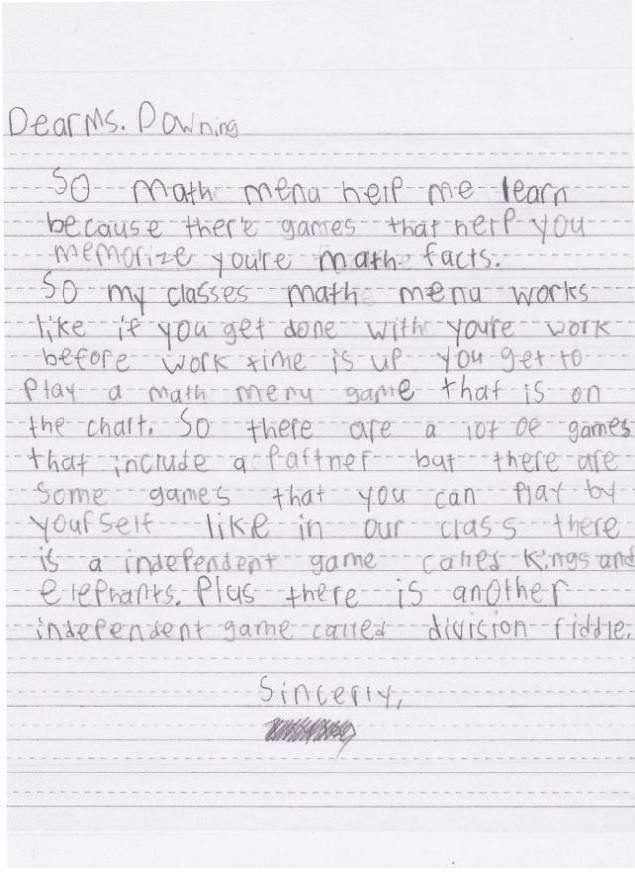
This letter highlights the difference between individual and partner menu activities.

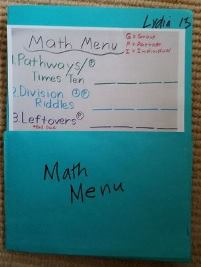
Thank you for this post. I too read your earlier blog post, and this answers some of my own questions as well. I especially appreciate the specific details about materials- sometimes seeing an image of a student folder or of materials can make all the difference in a strategy or approach like math menus seeming more do-able for others. I will be sure to share this with teachers I work with!
I see Math Menus in the lower grades. But, how does this work in the upper grades, where teachers have upwards of 150 students? I am specifically thinking of the tracking and journals.
Thanks, Mia, for your question. I think it’s an important one, and reminded me of my first years of teaching when I taught, as you describe, about 150 students a day, five classes with 30-ish in each. As I think back to those 52-minute periods, it was pretty crazy making. And as I revisit that time, I think I would do many things differently. One would be to incorporate menus. A menu would have options for students to do when they completed their work and had extra time, it would be used for particular units that I’d teach where I wanted students to think about an idea from different perspectives, and it would be ideal for days when I was out sick and was stressed about leaving plans for substitutes. Instead of a specific lesson, the students could work on menu tasks.
Two years ago, when our grandson Charlie was a 7th grader, I visited his math class from time to time. In a previous blog, Alphabetical Probability I explained that the lesson I described was “part of a larger menu that included other investigations and class charts for recording.” I’ve dug through my files when I was preparing that blog post and found the list for that Probability Menu. Annie, Charlie’s teacher, used the menu with all three of her seventh grade classes.

When I wrote the Alphabetical Probability blog, I had intended to make it more of a “how I use menus” blog. Maybe I’ll resurrect that idea. Stay tuned.
In the meantime, if you’re interested in how menus can be incorporated into a unit, you might check a book written by Cheryl Rectanus, Math By All Means, Area and Perimeter, Grades 5-6. I’m not sure the topic meets your needs, but you’d see how a teacher incorporated a menu as an integral aspect of her instruction.
When I taught middle school, I had students do all of their reflections on one page of their spirals for each unit (the rest was class work/notes and homework). I didn’t have them write a reflection every day, but at least once a week.
The “Goals and Reflections” page had the most interesting writing to me. We put a post-it on this page to find it easily. I collected these spirals on test days and read this one page for each student. I could get through them during each class period.
Another secondary thought about math menus – this is a way to structure homework choice, too. There can be required problems or activities and then choices for challenge or scaffolds.
Marilyn – thank you for your thoughts on the “Big Three” – those are the million dollar questions!
This post is very critical right now with a lot of buzz around guided math groups and math workshop. Thanks for reminding me about what’s important and anchoring the work we do.
Thanks for addressing real and immediate concerns that classroom teachers have: how to engage “fast finishers”, how to free up time to work with individual kids, and how to differentiate work in a meaningful way. I’m especially drawn to the reflection time at the end of the lesson. Often kids are working right up to the final minute of the period, then hurriedly packing materials up to move on to the next subject. Building in that reflection time is important.
One way I like to manage journal responses that would be easier that lugging spiral notebooks around is if your kids have access to technology. Using a google form or google classroom really allows you to quickly assess and respond to reflections and then have a record of them quickly. I’ve also tried using exit slips as opposed to journal entries a couple of times a week…that way, I read it quickly and can easily glance at who has handed one in and who hasn’t as kids hand them to me on their way out the door. It’s much less cumbersome than collecting a notebook.
Another idea to help with reviewing the reflection is to have the students read one or two of their favorite reflection each week. They can record the reading using Seesaw or another digital portfolio. You can then listen to their reflection, and so can their parents/adults in their life!